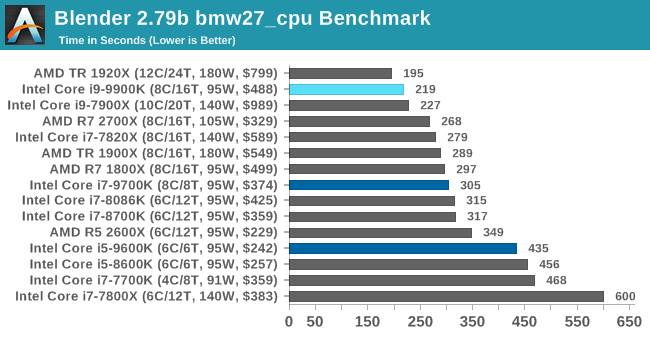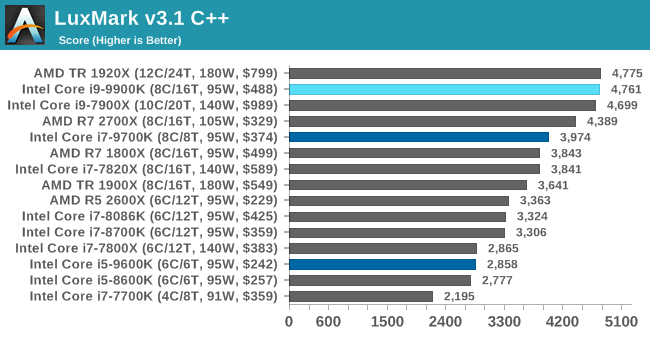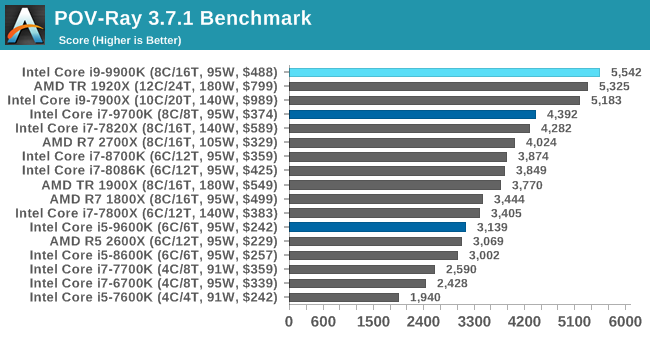The Intel 9th Gen Review: Core i9-9900K, Core i7-9700K and Core i5-9600K Tested
by Ian Cutress on October 19, 2018 9:00 AM EST- Posted in
- CPUs
- Intel
- Coffee Lake
- 14++
- Core 9th Gen
- Core-S
- i9-9900K
- i7-9700K
- i5-9600K
CPU Performance: Rendering Tests
Rendering is often a key target for processor workloads, lending itself to a professional environment. It comes in different formats as well, from 3D rendering through rasterization, such as games, or by ray tracing, and invokes the ability of the software to manage meshes, textures, collisions, aliasing, physics (in animations), and discarding unnecessary work. Most renderers offer CPU code paths, while a few use GPUs and select environments use FPGAs or dedicated ASICs. For big studios however, CPUs are still the hardware of choice.
All of our benchmark results can also be found in our benchmark engine, Bench.
Corona 1.3: Performance Render
An advanced performance based renderer for software such as 3ds Max and Cinema 4D, the Corona benchmark renders a generated scene as a standard under its 1.3 software version. Normally the GUI implementation of the benchmark shows the scene being built, and allows the user to upload the result as a ‘time to complete’.
We got in contact with the developer who gave us a command line version of the benchmark that does a direct output of results. Rather than reporting time, we report the average number of rays per second across six runs, as the performance scaling of a result per unit time is typically visually easier to understand.
The Corona benchmark website can be found at https://corona-renderer.com/benchmark

Corona is a fully multithreaded test, so the non-HT parts get a little behind here. The Core i9-9900K blasts through the AMD 8-core parts with a 25% margin, and taps on the door of the 12-core Threadripper.
Blender 2.79b: 3D Creation Suite
A high profile rendering tool, Blender is open-source allowing for massive amounts of configurability, and is used by a number of high-profile animation studios worldwide. The organization recently released a Blender benchmark package, a couple of weeks after we had narrowed our Blender test for our new suite, however their test can take over an hour. For our results, we run one of the sub-tests in that suite through the command line - a standard ‘bmw27’ scene in CPU only mode, and measure the time to complete the render.
Blender can be downloaded at https://www.blender.org/download/

Blender has an eclectic mix of requirements, from memory bandwidth to raw performance, but like Corona the processors without HT get a bit behind here. The high frequency of the 9900K pushes it above the 10C Skylake-X part, and AMD's 2700X, but behind the 1920X.
LuxMark v3.1: LuxRender via Different Code Paths
As stated at the top, there are many different ways to process rendering data: CPU, GPU, Accelerator, and others. On top of that, there are many frameworks and APIs in which to program, depending on how the software will be used. LuxMark, a benchmark developed using the LuxRender engine, offers several different scenes and APIs.

Taken from the Linux Version of LuxMark
In our test, we run the simple ‘Ball’ scene on both the C++ and OpenCL code paths, but in CPU mode. This scene starts with a rough render and slowly improves the quality over two minutes, giving a final result in what is essentially an average ‘kilorays per second’.


POV-Ray 3.7.1: Ray Tracing
The Persistence of Vision ray tracing engine is another well-known benchmarking tool, which was in a state of relative hibernation until AMD released its Zen processors, to which suddenly both Intel and AMD were submitting code to the main branch of the open source project. For our test, we use the built-in benchmark for all-cores, called from the command line.
POV-Ray can be downloaded from http://www.povray.org/












274 Comments
View All Comments
Ian Cutress - Monday, October 22, 2018 - link
Emn13: Base code with compiler optimizations only, such as those a non-CompSci scientist would use, as was the original intention of the 3DPM test, vs hand tuned AVX/AVX2/AVX512 code.just4U - Saturday, October 20, 2018 - link
The only problem I really have with the product is for the price it should have come with a nice fancy cooler like the 2700x which is in it's own right a stellar product at close to 60% of the cost. Not sure what intel's game plan is with this but It's priced close to a second gen entry threadripper and for it's cost you might as well just make the leap for a little more.khanikun - Monday, October 22, 2018 - link
I'm the other way. I'd much rather they lower the cost and have no cooler. Although, Intel doesn't decrease the cost without the cooler, which sucks.I'm either getting a new waterblock or drilling holes in the waterblock bracket to make it fit. Well I just upgraded, so I'm not in the market for any of these procs.
brunis.dk - Saturday, October 20, 2018 - link
no prayers for AMD?ingwe - Friday, October 19, 2018 - link
I don't see the value in it though I understand that this isn't sold as a value proposition--it is sold for performance. Seems to do the job it sets out to do but isn't spectacularly exciting to me.jospoortvliet - Saturday, October 20, 2018 - link
Given how the quoted prices ignore the fact that right now Intel CPU prices art 30-50% higher than MSRP, yes, nobody thinking about value for money buys these...DanNeely - Friday, October 19, 2018 - link
Seriously though, I'm wondering about the handful of benchmarks that showed the i7 beating the i9 by significant amounts. 1-2% I assume is sampling noise in cases where the two are tied, but flipping through the article I saw a few where the i7 won by significant margins.Ian Cutress - Friday, October 19, 2018 - link
Certain benchmarks seem to be core-resource bound. In HT mode, certain elements of the core are statically partitioned, giving each thread half, and if only one thread is there, you still only get half. With no HT, a thread gets the full core to work with.0ldman79 - Friday, October 19, 2018 - link
I'd love to see some low level data on the i5 vs i7 on that topic.If the i5 is only missing HT then the i7 without HT should score identically (more or less) with the i5 winning on occasion vs the HT enabled i7. I always figured there was a significant bit of idle resources (ALU pipelines) in the i5 vs the i7, HT allowed 100% (or as close as possible) usage of all of the pipelines.
I wish Intel would release detailed info on that.
abufrejoval - Friday, October 19, 2018 - link
Well I guess you should be able to measure, if you have the chips. My understanding has alway been, that i7/i5 differentiation is all about voltage levels with i5 parts needing too much voltage/power to pass the TDP restrictions rather than defective logic precluding the use of 'one hyperthread'. I find it hard to imagine managing defects via partitions in the register file or by disabling certain ALUs: If core CPU logic is hit with a defect it's dead, because you can't isolate and route around the defective part at that granularity. It's the voltage levels on the long wires that determine a CPUs fate AFAIK.It's a free choice between a lower clock and HT or the higher clock without HT at the binning point and Intel will determine the fate of a chips on sales opportunities rather than hardware. And it's somewhat similar with the fully enabled lower power -T parts and the high-frequency -K parts, which are most likely the same (or very similar) top tier bins, sold at two distinct voltage levels yet rather similar premium prices, because you trade power and clocks and pay premium for efficiency.
Real chips defects can only be 'compensated' via cutting off cache blocks or whole cores, but again I'd tend to think that even that will be more driven by voltage considerations than 'hairs in the soup': With all this multi-patterning and multi-masking going on and the 3D structures they are lovingly creating for every FinFeT their control over the basic structures is so great, that it's mainly the layer alignment/conductivity that's challenging the yields.